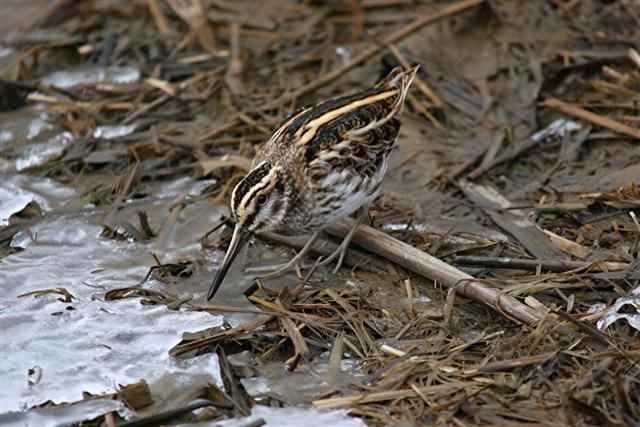
Jack Snipe: A cryptically engaging subject. Compared with Snipe, note the lack of a median crown stripe, short two-toned bill, striking back-stripes and streaked underparts. Watch for the comical bouncing action of birds feeding in the open, often the first clue to their presence (photo: Terry Dabner).
The beauty of birding is that it provides a broad canvas for folk to pursue their interests, be that chasing rarities, self-finding, patch-watching, survey work, or whatever. What is superb though is that something memorable can happen at any moment, just around the next corner, the next clump of trees, the next field, you never quite know. From many years birding I'm very fortunate to have amassed a decent collection of "memorable moments". These have come in many shapes and guises, but one occurred not half a mile away from where I live, with one of my favourite species of bird!
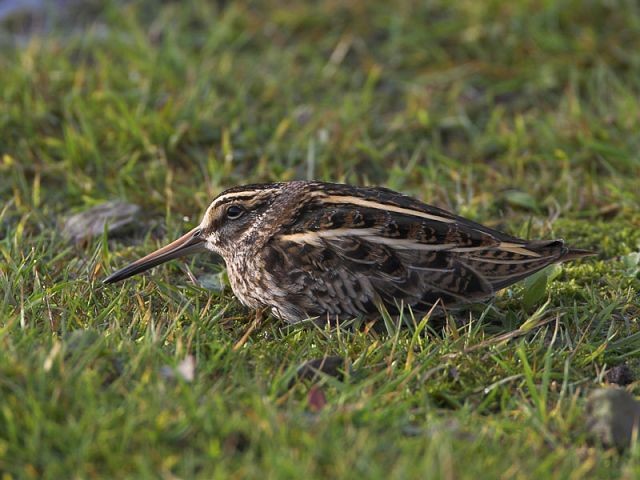
Jack Snipe: Migrants can often present approachable subjects, and I've heard of tired birds even allowing themselves to be picked-up! (photo: John Anderson).
It was a late October day and I had been 'trogging' around various sites in the Lower Derwent Valley NNR (LDV) just southeast of York (North Yorkshire) for much of the day. The flood meadows bordering the River Derwent were relatively damp after a few days of rain, though areas of standing water were few and far between. Late in the day I found myself at one of my favourite parts of the LDV, a 50-hectare site adjacent to the river. A quick glance revealed little of interest. I was unsure whether to bother heading down to the hide — there was little in the way of obvious water and everything looked very quiet indeed. At the last minute I changed my mind and within ten minutes I was positioned in the hide. After several 'sweeps' it seemed a bad decision — nothing was there, the whole area was devoid of birds! Or so it appeared. A small group of Snipe got up from nowhere, so as a last ditch attempt to do something useful with the last few hours of warm October daylight I opted to do an impromptu 'Snipe survey', in the hope of perhaps putting up one or two Jack Snipe.
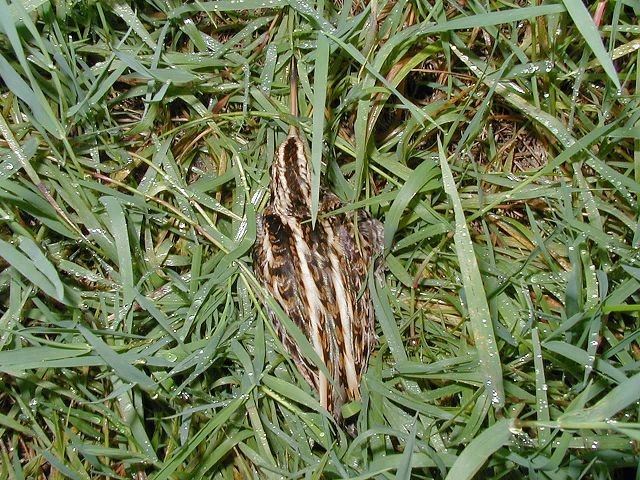
Jack Snipe: Refusing to flush until the last. Birds characteristically crouch low, shuffling into the surrounding vegetation. This bird is conspicuous against the grass around it; one amongst dead vegetation would be perfectly camouflaged (photo: Russell Slack).
The first signs were not good. The area that I headed towards produced just a handful of rasping Snipe, noisily escaping my presence. I changed the game plan and concentrated solely on Jacks. I headed to the dryer parts of the site, areas with flattened vegetation. Almost immediately a flutter of wings got up at my feet and the familiar shape of a Jack Snipe rose before me. I continued my search, another Jack got up, then another, I weaved back on myself and two more got up from an area that I had just crossed — I must have walked 'over' them! Over the next 20 minutes, as I weaved my way through the habitat, I flushed no fewer than 23 Jack Snipe, by far and away the largest number I had ever seen in one place. What was interesting was that several small parties of three and four got up, and several times the birds must have been literally centimetres from my mud-caked boots before they chose to flee. For me, this was really a day to remember of the highest calibre; not only had I managed to amass one of the largest numbers of Jack Snipe ever recorded in the LDV, but it was a real privilege on a glorious day to be able to watch so many of this fine wader in such a confined setting. So much for me thinking that there was nothing to see when I first debated whether to bother with the site or not!
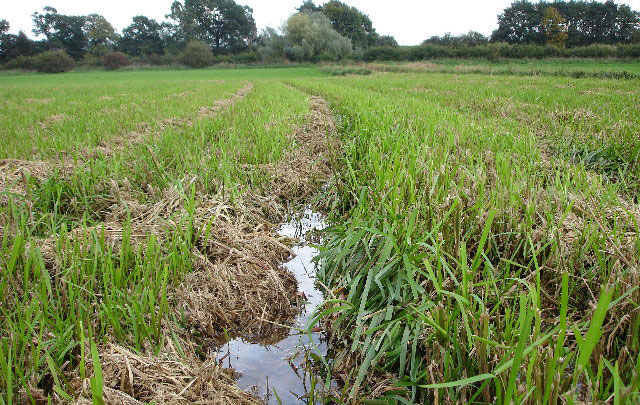
Lower Derwent Valley NNR, N. Yorks: Nothing to see? In my local area birds prefer a mixture of damp areas with taller vegetation close by for resting up during the day. A better understanding of their requirements during passage periods has enabled various parts of the LDV to be better managed for birds as they pass through, presumably en-route to locations much further south (photo: Russell Slack).
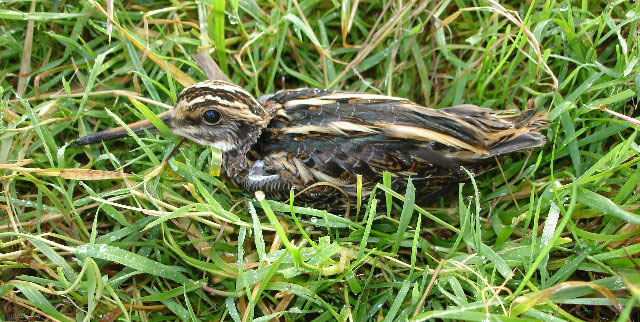
Jack Snipe: 'Creeping up' on a Jack Snipe at rest is exceptionally difficult to do, they will sit tight until the last minute (photo: Russell Slack).
Jack Snipe are another of those 'bogey birds' for birders when they're first starting out. There is no doubt that the species can be a challenging find even for more experienced birders, due to their secretive and skulking habits and also because their preferred habitat is often shunned by birders in search of more profitable locations. However, for me it is one of those species that always makes a worthy entry in my logbook for the day!
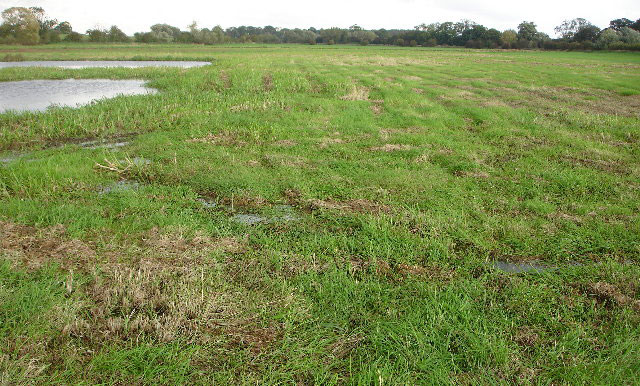
Lower Derwent Valley NNR, N. Yorks: Jack Snipe invariably rise from the driers areas, tending to favour the dead vegetation, which presumably affords them better camouflage (photo: Russell Slack).
Range
The breeding range extends from north-eastern Europe to eastern Siberia. The wintering range extends from western and southern Europe and North Africa eastwards to Southeast Asia. Their arrival here takes place from mid-September onwards, with numbers peaking in October and November. Hard-weather movements can provide further influxes during the winter. Many of the earlier birds carry on moving south, to winter in Europe and North Africa. Birds ringed in Britain during the autumn have been recovered from France, Spain and Tunisia.
Nowhere are Jack Snipe common, and it is estimated that the UK supports up to a quarter of the 'guesstimated' European wintering population of at least 44,000 birds. Those familiar with this secretive species will, of course, realise that such numbers are pure guesswork.
The Lower Derwent Valley Study
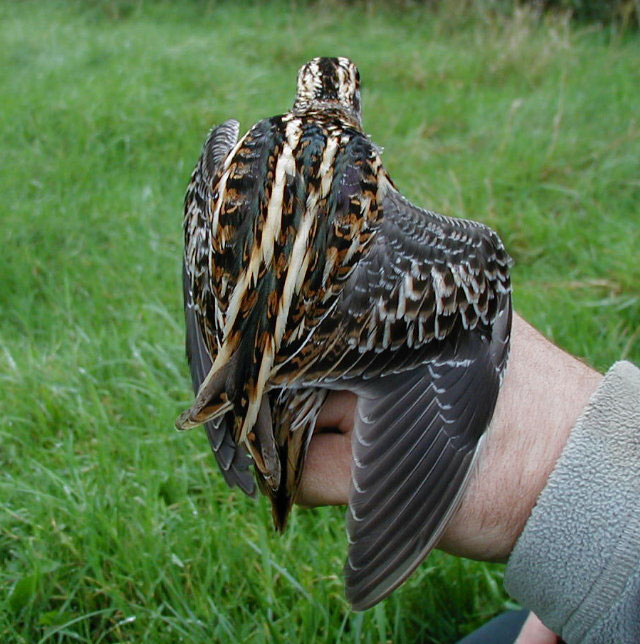
Jack Snipe: The back is a mixture of purple and green sheens, contrasting with the golden-yellow back-stripes. Also obvious here is the dark wedge-shaped tail and the white trailing edge to the secondaries shared with Snipe (photo: Russell Slack).
Jack Snipe have been studied in the Lower Derwent Valley NNR since autumn 1999. In addition to standard counts, intensive searches and a program of ringing birds at favoured sites have been carried out to produce more accurate population estimates. At one site during October 2002, observations from the hides by reserve staff, volunteers and visiting birders suggested one or two birds to be present. However, a total of 24 birds were caught and ringed at the site at this time and mark-recapture analysis of the data suggested perhaps up to 60–70 had used the area during the study period. At another one-hectare site, during October 2005, totals of up to 14 birds were recorded while seven were caught and ringed. Much of this work has rewritten estimates of the numbers present in the LDV at certain times of the year; intensive study of other suitable areas would doubtless do likewise.
Of the birds ringed so far in the LDV, none have been recovered elsewhere, and none have been retrapped in subsequent years. It is still early days in this study and these statistics may reflect the amount of suitable habitat available in the LDV and the number of birds using the site. All birds have been caught in October and these may be on passage rather than 'wintering' birds. It is hoped at some point to be able to radio-track some of the birds to find out what they are doing during the night as well as the day — it appears that separate daytime roosts and nightime feeding areas exist. As the technology becomes smaller, perhaps even satellite-tracking birds back to breeding areas may be possible (as has already been done for Whimbrel passing through the LDV; click here for more details of that study).
How, and where, to see Jack Snipe
You don't need to live next to a fantastic bird reserve, or coastal hot-spot, to see Jack Snipe. They can be found on slag heaps, the corners of rough fields and of course many of the areas in which you find Snipe wintering, though the small version is always the rarer of the two. Often the most unassuming piece of habitat can be a haven for Jack Snipe!
Unfortunately the best way of seeing Jack Snipe is to 'flush' them. However, such practice should not be undertaken on a regular basis at the risk of moving the birds away from the wintering site. Even this strategy can sometimes be frustrating — often at the last, when you have given up, a bird gets up at your feet! They don't have superb camouflage for nothing. Even in areas where I know Jacks are present, or where I've seen a bird drop, they can be exceptionally difficult to see on the ground. At sites that I regularly survey for the species, I've often tried walking two steps and scanning, walking two steps then scanning, but success at seeing a bird on the ground is miniscule. More often than not you've walked past (or over!) one, only for the bird to get up when you least expect it.
Sometimes at gravel pits and scrapes there is an obliging bird that is more showy than its comrades, such individuals often providing many with their best-ever views of the species. If you are lucky enough to be able to watch a bird going about its business, you'll realise they are quite comical birds to observe, nonchalantly shuffling along, rhythmically bobbing up and down whilst probing the mud for their prey. Their bobbing behaviour often betrays their presence at the water's edge.
The number of sites where Jack Snipe can be seen are far too plentiful to list here. Those of you heading to the Isles of Scilly will no doubt view birds at Porthellick Pool and Lower Moors on St. Mary's. During the autumn, birds may be encountered at passage locations along the east coast and on the Northern Isles. Also at this time, birds move through suitable inland locations.
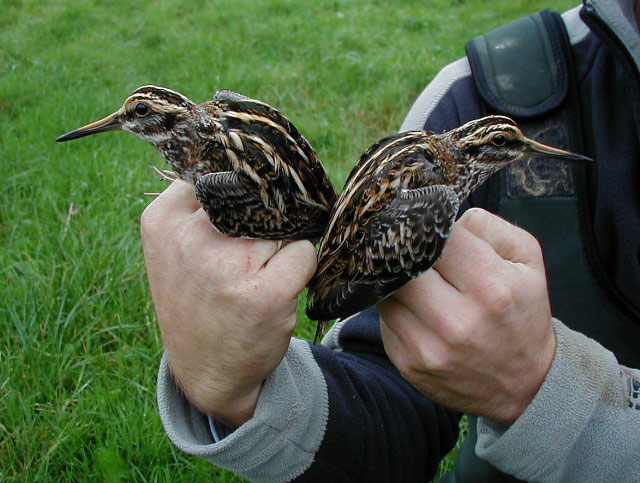
Jack Snipe: Monitoring and ringing sessions in the LDV are rewriting the status of this secretive bird in the area, with counts extrapolated to three figures at certain times of the year. Public sessions also allow birders to obtain excellent views of these super birds (photo: Russell Slack).
Identification
Unlike its vocal cousin, Jacks are mostly quiet, apart from the sound of the wings. The call, if given, is a low and weak 'cah', resembling a sigh.
The views that most of us obtain of Jacks are in flight. Upon flushing they rise with hesitant wing-beats, with the body quite upright in posture. The flight comprises quick wing-beats. Unlike Snipe, the flight is less erratic, and rarely lasts long, with birds usually returning to ground quickly, raising their wings at the last moment before landing.
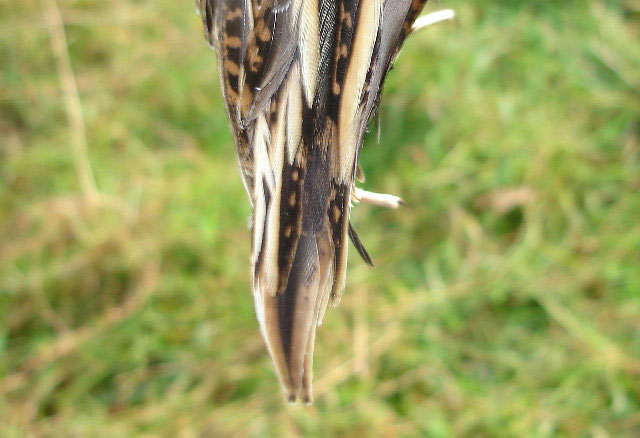
Jack Snipe: The tail differs markedly from Snipe, not only in the number of tail feathers, but also being dark and with a distinct 'wedge-shape' (photo: Russell Slack).
Other features to look for on birds in flight are: their smaller size, striking golden 'braces' on the back and a short, dark, wedge-shaped tail. Also evident in flight are the short bill and 'domed' head. As with Snipe there is a white trailing edge to the secondaries.
 |  |
| Jack Snipe: The short bill is about one and a half times the length of the head (photo: Steve Round). | Jack Snipe: Note the split golden supercilium (photo: John Judge). |
 |  |
| Jack Snipe: The crown lacks a pale median crown-stripe (photo: Russell Slack). | Jack Snipe: A noticeable dark crescent is found below the eye (photo: Russell Slack). |
Under the privileged view of birds on the ground then identification is relatively straightforward as long as you remember a few key features; sometimes it can be difficult to take in the intricate detail of this superbly attractive species. Unlike Snipe, there is no median crown stripe. So, if the bird in front of you has a pale central line to the crown it's not a Jack! Further features to look for include a split golden-coloured supercilium which has a thin dark line running through it and a dark crescent under the eye.
The stout bill (less than twice the head length) is pale yellow and has a darker tip, making it look almost two-toned. The upperparts are glossy, with hues of green and purple, which highlight two superb golden back stripes. The underparts lack the nice barring of Snipe, and are streaked.
Public ringing sessions
A nice aside to the study of birds in the LDV was the decision in autumn 2005 to invite birdwatchers along to the ringing sessions, much like the popular European Storm-petrel events advertised along the east coast. Three public events were held during October 2005, all proving popular, and all three allowing the comparison of Jack Snipe and Common Snipe in the hand, with additional photographic opportunities as the birds were released.
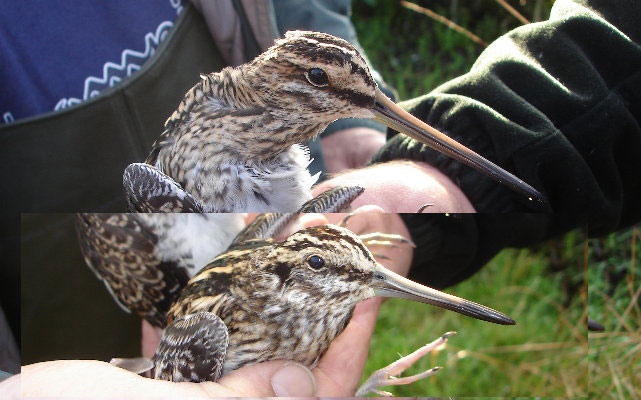
Snipe (top) Jack Snipe (bottom): Ringing sessions also allow direct comparison of the two species side-by-side, allowing appreciation of the differences in head pattern, as well as the different bill lengths (photo: Russell Slack).
Natural England Staff, alongside the Huddleston and Jackson Ringing Partnership, will be holding more events in the next few weeks (October and November 2006). These events will be advertised on Bird News Extra and the next is planned for Saturday 28th October. Meet at North Duffield Carrs car park at 8.30 am. Please remain in the car park as the birds will be brought there. As the event is dependent on the weather (and Jack Snipes being present!), confirmation will be posted on the news page.
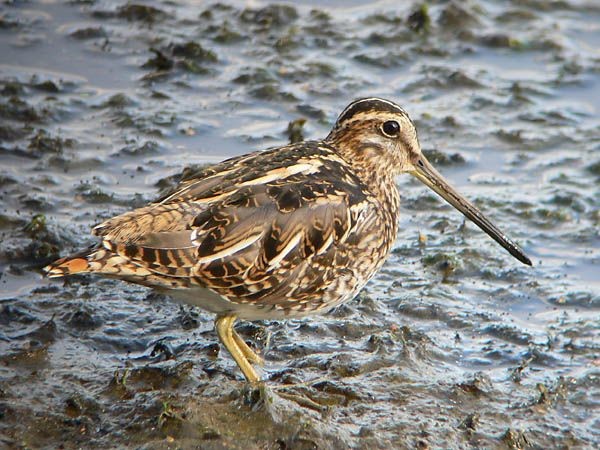
Snipe: The bill of Snipe is at least twice the length of the head (photo: Russell Hayes).
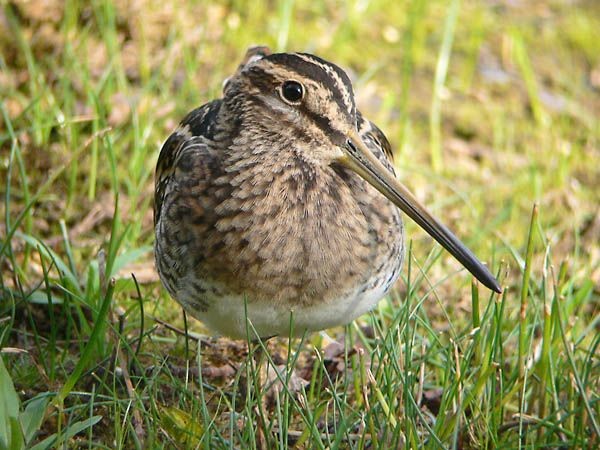
Snipe: Snipe also lacks the split supercilium, dark crescent below the eye, and, most obviously, has a pale median crown-stripe (photo: Russell Hayes).
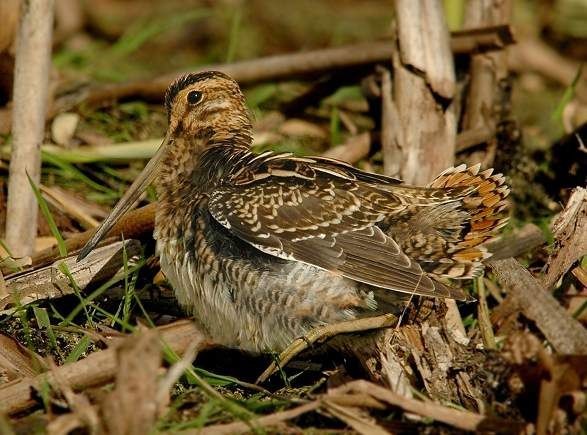
Snipe: The tail of Snipe has white tips, and comprises of 14 tail feathers, compared to 12 on Jack (photo: John Robinson).
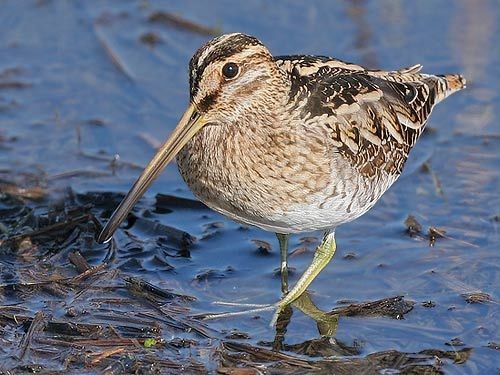
Snipe: The underparts of Snipe are barred, never as strongly streaked on the breast and flanks as Jack (photo: Steve Round).
References
Cramp and Simmons. 2004 Birds of the Western Palearctic interactive. Published by BirdGuides, Sheffield.
Brown and Grice. 2005. Birds in England. Poyser, London.
Svensson, L., Grant, P.J., Mullarney, K., Zetterstrom, D. 1999. Collins Bird Guide. HarperCollins, London.
Wernham, C., et al. 2002. The Migration Atlas: Movements of the birds of Britain and Ireland. T and AD Poyser, London.
Ralston, C S. 2005. Birds of the Lower Derwent Valley: A Historical Review 1850-2002. English Nature.
Acknowledgements
Many thanks to Craig Ralston, Assistant Site Manager LDV, for providing data from the LDV study.


